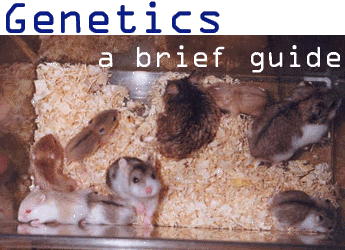 (gleaned from emails I wrote to the list: tusmc_hamsters-subscribe@yahoogroups.com, modified and edited Genetics sections for each type of hamster coming up. If you would like to help, please emal me. |
| There are actually many different species of "hamsters" and animals breed within the species as this is what usually designates the classification "species" in the animal kingdom. Dwarf hamsters and syrian hamsters belong to a number of different species and cannot interbreed (the two russian dwarf species can produce young but these are usually infertile. Also, this breeding is not advised). In the category dwarf hamsters, there are the roborovskis, the chinese dwarf hamster and the russian dwarfs (winter whites and campbells). The robos presently have only one type of colouring. The genes that control colours and other characterestics in syrians and dwarfs are different and act differently. |
|
Finding out the genetic makeup |
|
I think all breeders would be keen to learn some as it means that they can predict the kind of hamsters they can breed and can make decisions on what traits they would like to breed for. For example, I knew of the breeding of striped or piebald syrians to get almost white hamsters and actually wanted to try with the dwarf mottleds. A breeder told me that better patterning can actually be had but then, there was the incidence of all white hammies which died so this wasn't a good way of going about it. Knowing stuff like this can help the breeder tremendously, no? One can definitely avoid getting hamsters that are eyeless (Anopthalmic White gene; Roan and White Bellied), teethless (the red eyed mottled gene) or bald (the syrian satin gene). Also, the light grey gene is prenatal lethal, meaning it will reduce the numbers in a litter but not give pups with birth defects. (Many thanks to Lorraine Hill for correcting the genetics concerning the eyeless hamster). We will be able to find out some of the genes a particular hamster has from what its parents are like, what its babies are like and what its babies' babies are like. Because our hammies aren't from breeders and we don't know their pedigrees, we can only deduce from the litters they produce. For example, if Twinkie and Buttercup(golden satin) did have a satin baby, we'd know that Twinkie was heterozygous, or carrying both the different copies/alleles. (perhaps those imported expensive hamsters have a pedigree cert. - one should definitely ask if there is one before buying) |
|
How do I do it? For the syrian hamster, please
visit the SOEHC genetics pages to help you calculate your
hamster's genetic makeup. |
|
In syrians the satin gene is semi dominant. Do
not mate two satin hamsters as the babies will have very little fur. To
avoid this, pair one satin to one normal - the litter produced with
have both satins and In dwarf hamsters the satin gene is recessive (one copy is not enough to give the trait). If there is one normal and one satin parent, all their babies will be heterozygotes (and non satin) unless the the normal parent also posesses the satin gene. This means only the next generation with inbreeding will give satin babies. If copies of the gene can be
represented The normal satin animal is: Ss (one
S from father, s from mother)
For a normal X normal satin = ss X
Ss this leads to combinations of ss, ss, Ss, Kinda difficult to explain without a proper diagram of how it happens. |
|
Recently, I've corresponded with some people on the hml mailing list (hml@onelist.com) and with breeders in Britain, namely Emma Blatch, who so kindly wrote to tell me more about the breeding of mottleds. ALL-WHITE BABIES Some breeders have observed all white babies in their litters from mottled parents. These have not survived well. Here is Emma's description of the babies that were born to mottled parents "...a few albino babies which would stop growing around a week and a half (they would continue to develop but not at the same rate as the others) their limbs would twist round and appear deformed (they were still able to walk though, with quite some speed), their limb bones would only reach half way down the skin of the limbs, they soemtimes had eyes but not always, if they did have eyes they were pink rather than red, and eventually burst, they sometimes had teeth but not always, and because of the problems with the limbs they would fill their cheek pouches but would be unable to empty them." Although hamster parents do destroy unhealthy babies, Emma's mottleds did not destroy such babies. This occurance appears not to be well understood among many breeders but Lorraine Hill (author of the Complete hamster site) has written to say that it is the the MiMi combination that is the toothless white. Mo is the mottled gene, Mi is the Ruby Eyed mottled gene. MoMopp is the argente mottled and will not produce toothless whites. Becuase the mottled gene is dominant, one can still breed mottleds by mating one normal to one mottled. If you have more information, please email me to add to this page: email me at ivories@cheerful.com For more about dwarf genetics and genetics in general, please visit the Complete hamster site. |
